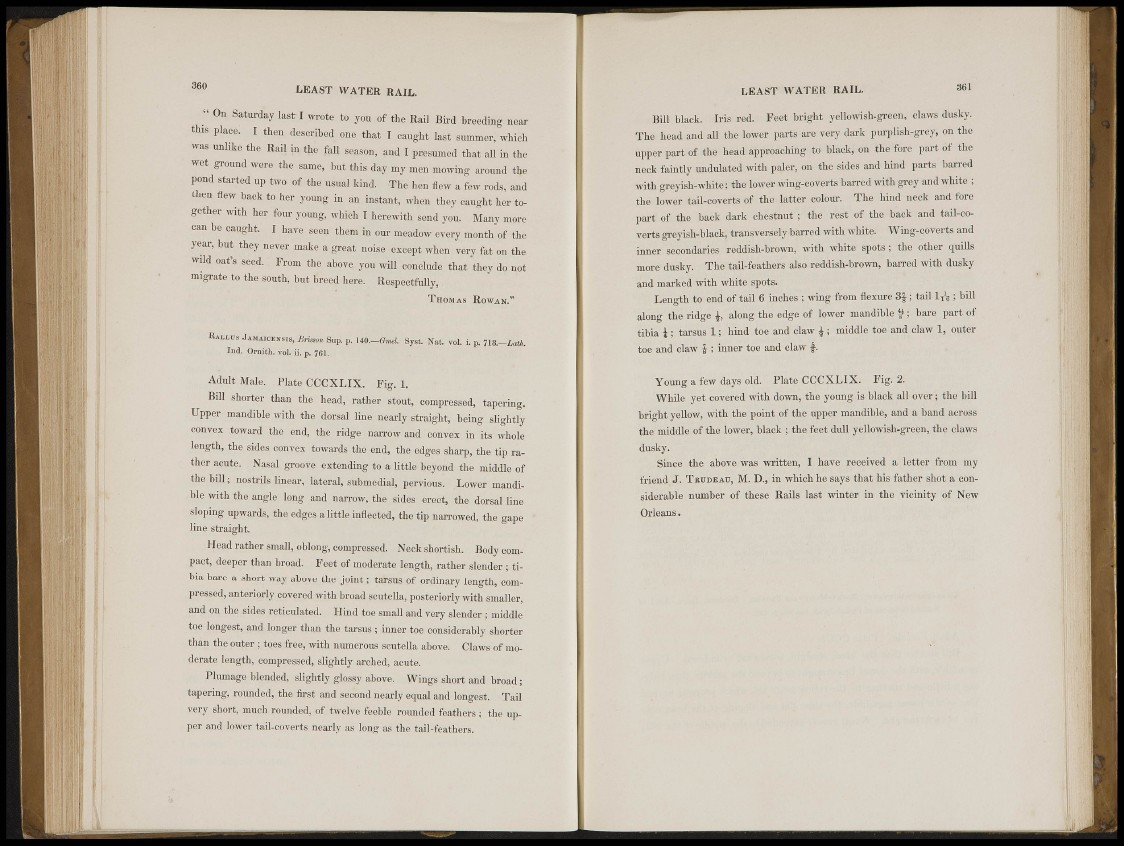
360 LEAST WATER RAIL.
" On, Saturday last-I wo,te, to you of the Rail Bird breeding »ear
this place. I then, ascr ibed one that I .aught last summer, which
was unlike tHe Ra4 p ^ ^ ^ and I p l ume d that all in
' *e,t g r o u n d were the same, but this day my men mowing around the
pond started up two of the usual kind. The hen Hew a lew rods, and
then flew back to her young in an instantt when they eaught-MrW
gether with her young, whiÈh I herewith send you Many more
can be caught. ^ i have seen them m mir meadow evgry month of the
year, but they never make a great noise except when, very fat op. the
wild oat's seed „ From the aboye yon w | | conclue that they do not
migrate to the south, but b r e e d s ! Respectfully,,
jaJiCigoMAS ROWAN."
RitiiM Jamaiceu i , Xrwon Sup p UO-V^iSyst Nat ™1. . p. 71».—Lath.
Ind Ormtb .Vol^n p 761
A l j i l t Malig^ PlaBcCCXLIX. Pig. 1.
Bin shorter than the head, rather stout, cojnpressod, tapering.
Upper- mandible with the dorsal line nearly straight, being slightly
Wnyex toward the end, fl« ridge narrow and convex in its whole
length, the sides convex towards the end, t i e edges sharp, the tip rather
acute. Nasai, groove extending to a little beyond the middle of
t h < ! ,,U1 ; '"«trils Iin.-ar,£la1er;il, submedial, pervious. Lower inandi-
: We with the anglgtl.mg and narrow, the sîd.^i|jgi, the dorsal line
sloping upwards, the cdges.a.Jitfle inilocte.1, the tip narrowed, the gape '
line straight.
Head rather small, oblong, compressed. Neck shortish. Body com*
pact, deeper than broad. Feet of moderate length, rather slender ; tibia
btee a short way above the joint ; tarsus of ordinary length, compressed,
anteriorly covered with broad scutclla, posteriorly with smaller,- '
and on the ,sides reticulated. Hind toe small and very slender ; middle
t o e longest, «"'I longer than the tarsus : inner toe considerably shorter
than the outpr : t.iesil'rce, with numerous scutella above: Claws of mpd
«ratc! length, compressed, slightly arched, acute.
Plumage gj.mded, slightly g t t l p above. Wings short and broad ;
tapering, rounded, the first and second nearly equal and longest. Tail
very short, mud) rounded, of twelve feeble rounded feathers : the upper
and lower tail-cov.erts nearly as long as the tail-feathers.
LEAST WATER RAIL. 361
Bill black. Iris red. Feet bright yellowish-green, claws dusky.
The head and ¡til the lower parts are very dark purplish-grey, on the
upper part' of the head approaching* Hack,- on the -fore part of the
neck faintly undulated with paler, on the sides and hind parts barred
with greyish-white; the lower wing-coverts barred with grey and white ;
the: lower tail-coverts of the latter colour. The hind neck and lore
parC.if the back dark chestnut ; the rfesf of the back and tail-coverts
greyish-black, transversely barred wi th whites Wing-coverts and
inner secondaries reddish-brown, with white spots; the other quills
more dusky. The tail-feathers also reddish-brown, barred with dusky
:md marked with white spots.
Length to end of tail 6 inches ,; wing from flexure 3 | ; tail ; bill
along the ridge i , along the edge of lower mandible § ; bare part of
tibia ±; tarsus L; hind toe and claw £ ; middle toe and claw 1, outer
toe and claw f ; inner toe and claw fl.
Young a few days old. Plate CCCXLIX. Fig. 2.
While yet covered with down, the young is black all over; the bill
bright yellow, with the point of the upper mandible, and a band across
the middle of the lower, black ; the feet dull yellowish-green, the claws
dusky.
Since the above was written, I have received a letter from my
friend J.^TfiUDEAU, M. 1)., in which he says that his father shot a considerable
number of these Rails last winter in the vicinity of New
Orleans.